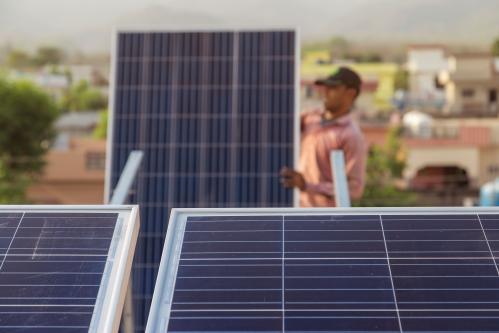This op-ed was originally published by Project Syndicate.
With less than three months until the United Nations climate change summit (COP26) in Glasgow in November, formal and informal discussions and pre-negotiations are now in full swing. A new U.S. administration recognizes the urgency of the situation, and there is much broader political support globally for ambitious climate policies. The world still has a chance to limit global warming to below 2 degrees Celsius compared to preindustrial levels.
But as a major new assessment from the Intergovernmental Panel on Climate Change shows, the race between climate change and emissions reductions remains tight. Limiting the damage already done will require the use of all available tools and broad global participation. As two recent carbon-pricing-related proposals demonstrate, however, there remain important differences between approaches to reach those goals.
The 2015 COP21 summit in Paris did not seek a binding international treaty that would impose policies on countries. Accordingly, the approach enshrined in the Paris climate agreement allowed for countries to declare their own voluntary emissions-reduction goals—Nationally Determined Contributions—and climate policies, with the understanding that these would become more ambitious over time.
And yet, the European Union has now proposed a carbon border adjustment mechanism (CBAM) that represents a departure from the voluntary spirit of the Paris accord. The new mechanism, part of a package of climate measures announced in mid-July, would impose the equivalent of tariffs on imports from countries where producers pay a carbon price below that of the EU’s, set either directly or through an emissions trading system (ETS).
Though the proposal is silent on regulatory measures that have an equivalent effect, it is reasonable to assume that the EU would be open to accepting them if they are ambitious enough. Such acceptance would be particularly important to avoid conflict with the United States, where regulations will likely continue to be the main part of climate policies.
At first, the EU’s CBAM would cover imports of relatively simple products—electricity, iron and steel, cement, aluminum, and some fertilizers—but it would be extended to other goods that would involve more complex value chains over time. Importers would have to buy CBAM certificates (reflecting carbon content) that would cost what the EU’s ETS permits cost domestic producers, thus effectively imposing the EU’s carbon price on exporters in countries subject to the CBAM.
The EU would apply the CBAM irrespective of the exporting country’s per capita income, and without regard for the principle generally agreed in Paris that developing countries need more time to adopt higher carbon prices or their equivalent. It is pushing ahead despite the fact that most developing countries cannot readily mobilize the large upfront financing necessary for large green investments.
Another recent proposal comes from senior staff at the International Monetary Fund, which envisions international carbon price floors (ICPFs), differentiated by national income levels. While the authors do not frame ICPFs explicitly as an alternative to CBAMs, they argue that agreed minimum but differentiated carbon prices would reduce the pressure for border-adjustment schemes and be more in keeping with the voluntary spirit of the Paris agreement.
An ICPF arrangement could at first involve just a few large emitters. For example, according to the IMF, if a “climate club” of just six participants could agree on minimum prices of $75 per ton of carbon dioxide for the U.S., Canada, the EU, and the United Kingdom as high-income countries, $50 per ton for China as a high middle-income country, and $25 per ton for India as a low middle-income one, this, in addition to current policies, “could help achieve a 23% reduction in global emissions below baseline by 2030.”
Although the EU’s CBAM and the ICPFs could operate simultaneously, the former requires the calculation of the carbon intensity of specific products. So, exporters from a country that is party to an ICPF agreement would still have to acquire the CBAM certificates, unless the EU were to exempt that country from its border-adjustment scheme on the basis of a “high enough” ICPF. But this would raise issues at the World Trade Organization, as it would imply different carbon border taxes, and thus different trade policies, for different countries.
A “new” climate-related CBAM exemption for low-income countries probably could be negotiated at the WTO, but a similar provision for middle-income countries such as China or India would face firm opposition from advanced economies. Yet, without such an exemption, the EU’s CBAM (or similar border measures by others such as the U.S.) will continue to trigger strong objections from middle- and lower-middle-income countries and could endanger a consensual global accord at the Glasgow summit.
In contrast, the IMF’s general approach has a chance of gaining universal support. An ICPF arrangement would face no WTO-related barriers, because it does not involve trade or trade-related policies, and joining the “club” would be voluntary and could take place at different times.
But the six-member example above is only illustrative—as the IMF acknowledges—and we should not let its simplicity deceive us. While the principle of ICPFs could be broadly appealing, specific income-related prices or equivalent policies would still have to be negotiated.
It is not at all obvious, for example, whether India would agree to a price floor of $25 per ton of CO2, or whether that price would be acceptable to the U.S. and the EU. Although some countries might adopt them, ICPFs should rather be interpreted as shorthand for a package of climate policies where the level and timing of ambition differ according to a country’s stage of development.
Ultimately, a universal agreement in Glasgow will require advanced economies to accept national differences in climate ambition. China’s commitments—given the level of the country’s emissions and its technological and economic capacity—will of course be crucial to achieving a satisfactory global accord.
As the carbon-pricing debate continues, rich countries may think the threat of CBAMs gives them useful leverage. But they should focus more on helping to mobilize the finance that most developing countries need for the green transformation. This would likely be a more effective way to shift the emphasis to the great opportunities arising from new technologies and achieve crucial global climate goals, while preserving the chance of a “whole of humanity” accord on this planetary challenge.






Commentary
Op-edThe carbon price conundrum
August 11, 2021